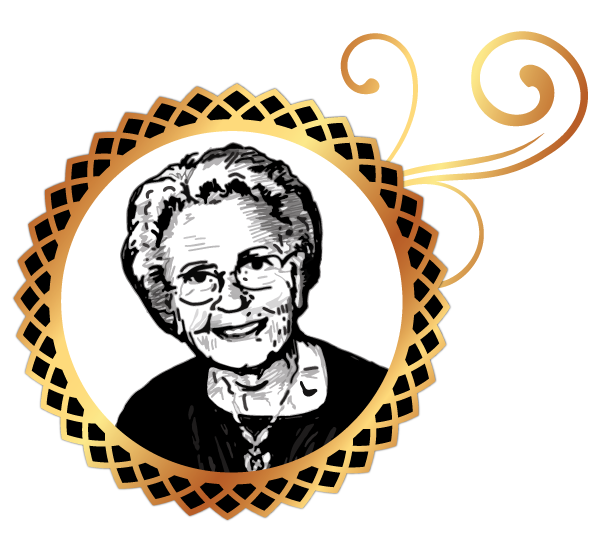As a company deeply seeded in family and tradition, it is only fitting to share Oma’s story of how her authentic cherry spirit recipe came to be. While we have always known her as “Oma” (which means Grandmother in German), her life and traditions began long before.
Hedwig Hintz (Oma) was born on January 23, 1925 in Germany. She was the fourth and youngest child. After losing her mother at a very young age to Tuberculosis, Oma’s father remarried. Although given the opportunity to join her older sister in going to live with an aunt, she was too much of a Daddy’s girl to leave home. Oma’s father and new wife went on to add four more children to the family.
Oma spent her childhood on a large farm with crops, fruit trees, and livestock. In the mornings before school, she would peel potatoes for the farm hands and occupied her evenings learning the skilled trades of tailoring and sewing from her stepmother. She remembers her family being the envy of the town when they would take their horse-drawn carriage to church on Sundays. Overall, Oma felt she had a very blessed childhood. Unfortunately, the beginning of World War II in 1939 changed all that.
Oma had just completed her German schooling, the equivalent of about 8th grade in America, and was hoping to further her education. Regrettably, on September 9th, fighting broke out between the German and Polish armies near Oma’s home. From the cellar of her family’s farm, her family hid and watched the Polish planes flying overhead and shooting at the Germans. At one point, the cellar caught fire, forcing the family to flee. Oma burned the bottoms of her feet running through the flames, but fortunately, the family was able to take cover in a ditch. They rode out the battle through the night as bullets blazed overhead from the crossfire. In the morning, when the fighting had subsided, they were able to return to their home. The family found twelve dead soldiers in their yard.
While the war continued, Oma spent the better part of her adolescent years feeling very unhappy. She was finally of age to take part in the traditional dance parties, but with all the men off at war all of the normal social activities for young adults were put to a halt. However, on occasion, the young women would roll back the rugs and play the gramophone while dancing with just one another. Even these small glimpses of normality came to a halt, as word spread that Russia would soon invade Germany. Against her will, Oma fled to live with her aunt and sister in Sprottau. Her stay in Sprottau was short lived, as the Russian army advanced there as well. She next tried for American occupied Rechenbach, but it too was quickly overrun by Russians. Oma spent many nights retreating to the basement to wait out bomb raids. One night, she was finally able to escape by riding a train to the border and sneaking a cross with a small group of people. Although ordered by the government to take in refugees, many German people were resentful.
Fortunately, Oma was able to get herself to Franzenburg where her aunt was already staying as a refugee. The same family reluctantly took her in, as well. They slept three to a bed, crossways, but Oma was happy to have a safe place to rest her head. Thanks to the skills she had learned from her Stepmother, Oma was able to land a job as a tailor’s apprentice. She rode a very old bike 7 kilometers to work in Kuhafen every day, until eventually; she was able to save enough money to rent her own room in the home of a family there.
In 1952, having never spoken a word of English and with just a handful of possessions, Oma immigrated to America. Although the war had ended, Oma, like many others, sought a better life than post-war Germany could offer. She received willing sponsors in Detroit, who sent her money for train fare for her journey from New York. Upon arriving in Detroit, one of her sponsors became very ill and Oma, once again, found herself looking for a home. As luck would have it, a neighbor found her accommodations and offered her language lessons. Before long, Oma took a job at Scofers Restaurant. Although it seemed like everything was finally falling into place, Oma just did not feel at home in America. She decided to set a goal to save enough money to return to Germany. However, by the time she had saved up enough money for her trip, she had adjusted to life in America and no longer wished to return. She began to view America as the land of opportunity and freedom, something she had not had since she was a young girl. Little did she know, America would also soon give her something even better…
Walter Steinbart (Opa), also immigrated to America in 1952 and worked as a farmer in Iowa. Unlike Oma, he had not yet found happiness with his time in America. He decided it was time to say farewell and make the journey back to Germany. Before departing, he made the trip to Detroit to say goodbye to family and friends living in the area. As luck would have it, Oma was currently boarding with these same friends. The two formed an immediate friendship, but Opa soon had to depart for his trip back. Before he left, Opa gave Oma a letter to mail for him. Before dropping it in the mail, Oma was excited to find the letter addressed to herself. Inside she found a romantic note asking her for a date. The rest was history. The two were married only four short months later in Detroit during the summer of 1954.
After the wedding, they decided to move to Lansing where Opa had family. Due to the past they had both endured, they lived their life frugally and worked hard every day. Oma worked in alterations at a local department store and sewed draperies on the side for an interior designer. Opa taught her how to drive the car they shared together. Opa painted homes in the evenings, after a full day of work as a masonry. During this time, Opa achieved his builder’s license and built a house for Oma and their two children.
Living in Michigan, the family had access to many freshly picked fruits. Summer vacations to the family lake house in Northern Michigan led to annual visits to the Traverse City area for picking cherries. While the family ate or canned many of the cherries, Oma and Opa started a new tradition of making homemade Cherry vodka. As part of the process, the cherries soaked in vodka in the same canning jar Oma still uses today. Etched in the family memories to this day, is the vision of brightly colored cherries in a clear glass jar sitting on the kitchen counter.
During their life together, Oma and Opa enjoyed hosting card parties for their family and friends. The parties would often last well into the night and included dancing on the linoleum floor in the basement with the record player humming songs from their German homeland. Of course, their ever-popular cherry vodka always fueled the parties.
After Opa passed in 2003, Oma continued to carry on the tradition of making her annual batch of cherry vodka for family and friends. Through the years, the family has grown and changed, but Oma’s homemade cherry vodka has remained a constant family tradition. Whether it be a graduation, baptism, or the toast at her grandchildren’s weddings, Oma’s cherry vodka is always a hit.
Wanting to carry on Oma’s legacy, her grandson Kyle decided to learn the trade. Oma helped Kyle to make his first round of cherry vodka in time to share with his own friends for the holidays. The batch was such a hit, that Kyle decided it was time to share with all. Today, everyone can enjoy Oma’s spirits and start their own traditions. The family only ask that while taking a sip, please remember to practice patience, believe in hard work, and honor tradition as Oma always did.


